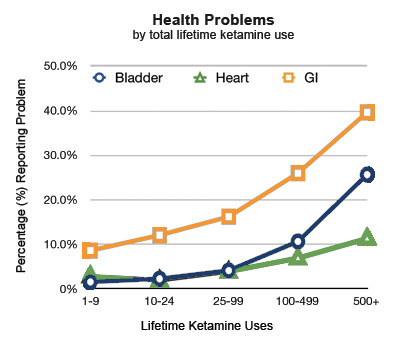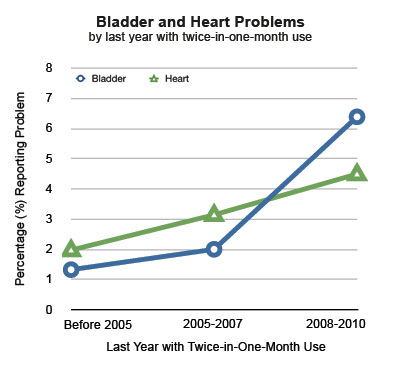Ketamine Use and Health 2010
Erowid Micro-Surveys
v1.0 - Nov 2010
Erowid Extracts #19
Citation: Erowid E, Erowid F. "Ketamine Use and Health 2010: Erowid Micro-Surveys". Erowid Extracts. Nov 2010;19:16-7. Online edition: Erowid.org/chemicals/ketamine/ketamine_article1.shtml
See also the companion article: KLUTS: Ketamine and Lower Urinary Tract Symptoms
Questions about the effect of ketamine use on the urinary tract have increased over the last few years, after the issue was first raised in the medical literature in 2007. Following a review of the existing literature in September 2010 for Jon Hanna's "KLUTS" article (pages 12-14), we were unable to locate any published epidemiological studies assessing how widespread the problem is.
To gather data about this issue, Erowid Center conducted three online surveys in October 2010 asking visitors about ketamine use and health. The first two were "micro-surveys" displayed at the top of pages across the site. The third was a longer survey that was only offered to people who identified that they had used ketamine at least once.
We received more than 30,000 valid responses to the first two surveys. A response was excluded from results if the respondent gave their age as under 10 or over 80 years old, or if responses were contradictory (e.g., different answers to number of ketamine uses between surveys 2 and 3). The first two surveys intentionally did not mention any specific health issues, in order to avoid prompting respondents.
Survey 1 (9,258 responses) asked four questions: age, total lifetime ketamine use, last year that ketamine was used at least twice in a single month, and a non-mandatory open response field asking what the top medical problems are that the respondent thinks ketamine use causes. In response to this open question, over half of respondents gave no answer or replied with some form of "I don't know". Of those who did reply, 314 (~3.4%) mentioned bladder or urinary problems, with other mentions including addiction (371), brain damage or "Olney's lesions" (292), heart problems or chest pain (97), nasal problems associated with snorting (90), and stomach and non-urinary abdominal issues (48).
Survey 2 (20,992 responses) consisted of two questions: age, and whether the respondent had ever used ketamine. The percent of respondents reporting that they had ever tried ketamine was consistent with survey 1.
Survey 3 (3,379 responses) had fifteen questions and was a follow-up offered to those who answered "yes" to having used ketamine on survey 2. It asked how many times ketamine had been used (either medically or recreationally), what year it had last been used at least twice in a single month, several questions about whether the respondent had experienced different types of medical problems that they related to their use of ketamine, and two questions about urinary tract health regardless of association with ketamine.
Unsurprisingly, the percentage reporting that they had experienced problems controlling their ketamine use (or felt addicted) increased as total lifetime use of ketamine increased. Over 50% of those who have used ketamine 100 times or more said they'd had trouble controlling their use.
Several findings from our surveys (details below) suggest that a more rigorous look at these issues should be conducted.
Questions about the effect of ketamine use on the urinary tract have increased over the last few years, after the issue was first raised in the medical literature in 2007. Following a review of the existing literature in September 2010 for Jon Hanna's "KLUTS" article (pages 12-14), we were unable to locate any published epidemiological studies assessing how widespread the problem is.
To gather data about this issue, Erowid Center conducted three online surveys in October 2010 asking visitors about ketamine use and health. The first two were "micro-surveys" displayed at the top of pages across the site. The third was a longer survey that was only offered to people who identified that they had used ketamine at least once.
We received more than 30,000 valid responses to the first two surveys. A response was excluded from results if the respondent gave their age as under 10 or over 80 years old, or if responses were contradictory (e.g., different answers to number of ketamine uses between surveys 2 and 3). The first two surveys intentionally did not mention any specific health issues, in order to avoid prompting respondents.
"There was a clear correlation between total lifetime use of ketamine and likelihood of reporting bladder/urinary problems [...]"
Survey 2 (20,992 responses) consisted of two questions: age, and whether the respondent had ever used ketamine. The percent of respondents reporting that they had ever tried ketamine was consistent with survey 1.
Survey 3 (3,379 responses) had fifteen questions and was a follow-up offered to those who answered "yes" to having used ketamine on survey 2. It asked how many times ketamine had been used (either medically or recreationally), what year it had last been used at least twice in a single month, several questions about whether the respondent had experienced different types of medical problems that they related to their use of ketamine, and two questions about urinary tract health regardless of association with ketamine.
Unsurprisingly, the percentage reporting that they had experienced problems controlling their ketamine use (or felt addicted) increased as total lifetime use of ketamine increased. Over 50% of those who have used ketamine 100 times or more said they'd had trouble controlling their use.
Several findings from our surveys (details below) suggest that a more rigorous look at these issues should be conducted.
 |
Of respondents to surveys 1 and 2, 36% said that they had used ketamine at least once, either medically or recreationally. As expected, respondents to Erowid surveys do not reflect the general U.S. population. The National Survey on Drug Use and Health estimates that around 1% of the U.S. population over 12 has ever tried ketamine (from 2006 results published in 2008).
|
 |
There was a clear correlation between total lifetime use of ketamine and likelihood of reporting bladder/urinary problems: 1.6% of those who report 1-9 uses in their lifetime, 2.3% with 10-24 uses, 4.1% with 25-99 uses, 10.6% with 100-499 uses, and 25.7% of those reporting 500 or more uses of ketamine. All medical problems were more likely to be reported with higher total lifetime use. Neither medical problems nor total lifetime use was correlated with age.
|
 |
People who had used ketamine more recently were much more likely to report health problems. Ketamine-caused bladder or urinary problems were reported by 1.3% of those whose last year with two or more ketamine uses in a single month was before 2005. 6.4% reported bladder problems if they last used ketamine at least twice in one month after 2007.
|
 |
The percent of respondents who reported using ketamine 25 or more times in their life was highest among those who had last used at least twice in a month in 2010 (42.1%). The more recently that users reported having used ketamine twice or more in a month, the more likely they were to report bladder problems related to use. This correlation was independent of age and of total lifetime use of ketamine.
|

